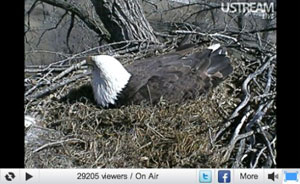In an article in The New York Times, Diane Ackerman refers to the phenomenon of "nature deficit" in children who spend very little time in the natural world and a lot of time with their technological toys. Adults seem to be following suit with millions of men and women watching a mother bird feeding her young ones in a nest that is being photographed live on two webcams.

Ackerman writes: "We're virtually at the pond. And without mud, sweat, or mosquitoes. No need to dress, share snacks, make conversation. Some of us may be taking a coffee break or going mentally AWOL during class or work." For many people, watching a screen has become the preferred way to view nature.
You'd think Ackerman, who has written many brilliant books containing her direct observations of animals in wild places, would disapprove of this approach. But oddly enough, she thinks that technology has whet our interest in both nature and the animal kingdom. Now we have the best of both worlds: the chance to explore the parks and streams with our own two legs in our communities, and the chance to use our computers to immerse ourselves in the daily activities of hawks and other hard-to-reach animals.
We agree with Ackerman and have reviewed many documentaries, books, and films about animals and nature. In fact, you can do an Advanced Search of Spirituality & Practice and discover 600 resources on 30 pages about Animals and nearly 1000 resources on 47 pages about Nature. We like to think of these resources as providing you with time to play, to pay attention, and to be enlightened by nature and animals.
